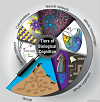
SENS5 - Epigenetic Drift and Aging
Main Video
© SENS Foundation 2011 - http://www.sens.org
The Fifth SENS conference - Silvia Gravina
Author:
S. Gravina
Albert Einstein College of Medicine
Recent data suggest that the epigenome is highly dynamic and serves as an interface between the environment and the inherited static genome. The large volume of epigenomic events and its continuous need of maintenance, i.e., after DNA repair or replication, suggests a high chance of errors. The question we wish to address is how unstable the epigenome really is. Do epimutations accumulate with age and do they occur in a random fashion, i.e., as 'epigenomic drift'? Do they ever reach levels that are high enough to have functional consequences? To experimentally determine epigenetic drift we focused on DNA methylation, a major layer of epigenomic control. To study intra-organ variation in DNA methylation during aging, it is necessary to have access to procedures that allow assessing DNA methylation patterns at the level of single-cells or single-molecules. Such methodology is currently entirely lacking: to fill this void we have optimized bisulfite sequencing for single cell analysis. The procedure developed allows us to analyze DNA methylation patterns in single cells, within promoter regions of genes or genome-wide. Data on mouse fibroblasts, neuronal nuclei and hepatocytes will be presented and discussed. We are currently applying the method to test the hypothesis that random DNA methylation changes accumulate in the mouse brain during aging, contributing to functional decline of somatic cells that gives rise to chronic pathology and aging. Apart from basic studies into cellular heterogeneity in organs and tissues in relation to aging and age-related pathology, this method can be applied in epigenetic diagnostics, e.g., in analyzing circulating tumor cells for pathogenic epimutations.
Other videos from BioScience
-

American Chemical Soci...
By: caliban
20 December 2019 - 11:47 AM -

Bioelectric Computatio...
By: Mind
12 December 2018 - 10:39 PM -

Bioelectric Computatio...
By: Mind
12 December 2018 - 10:39 PM -

The first head transpl...
By: caliban
04 March 2015 - 12:31 AM -

A Monkey Head Transplant
By: caliban
03 March 2015 - 11:12 PM -

NAD and Age reversal pt 4
By: to age or not to age
26 August 2014 - 06:49 PM -

NAD and age reversal pt 3
By: to age or not to age
26 August 2014 - 06:47 PM -

David Sinclair Intervi...
By: YOLF
17 March 2014 - 10:23 AM -

Caleb Finch
By: caliban
08 May 2012 - 09:14 AM -

SENS5 - The Future of...
By: jdgauchat
21 December 2011 - 07:44 PM








































